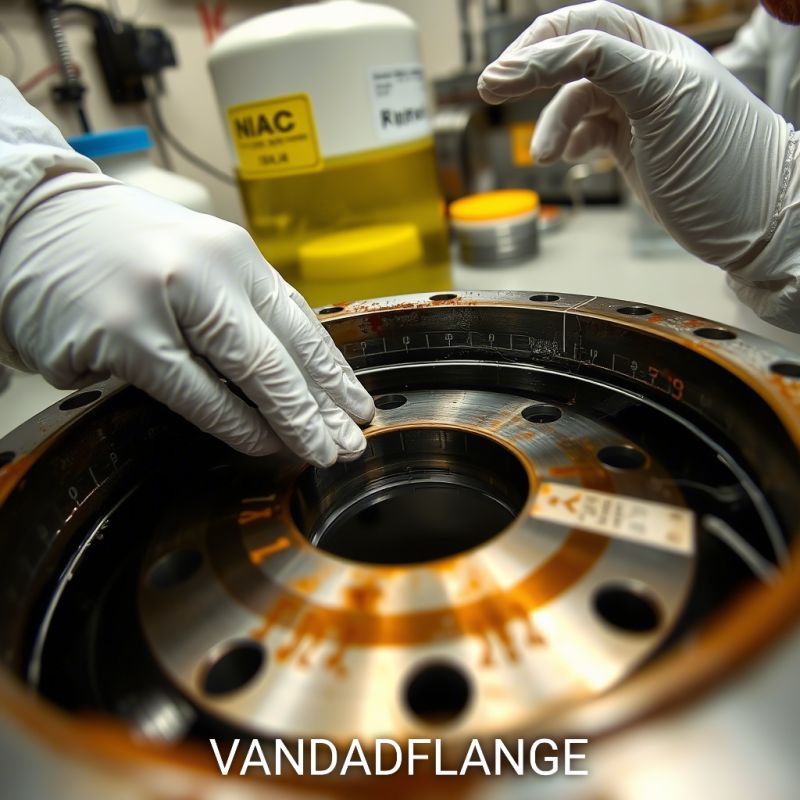تست HIC در استاندارد NACE؛
تست HIC (Hydrogen Induced Cracking) یکی از مهمترین آزمونهای خوردگی در محیطهای ترش (Sour Service) مانند صنایع نفت، گاز و پتروشیمی است که به بررسی مقاومت مواد فلزی (مانند فلنجهای فولادی) در برابر ترک خوردگی ناشی از هیدروژن میپردازد. این تست براساس استانداردهایی مانند NACE MR0175/ISO 15156 الزامی است و برای محصولات فورجی مانند فلنجها، کنترل عناصر شیمیایی (مانند کاهش سولفور و فسفر)، دستیابی به ساختار میکروسکوپی یکنواخت و رعایت حداکثر سختی ضروری است. همچنین، روشهای تولید مانند فورجینگ و عملیات حرارتی (نرمالایزینگ یا کوئنچینگ) نقش کلیدی در جلوگیری از تشکیل عیوب داخلی دارند.
برای اینکه یک فلنج در تست HIC (Hydrogen Induced Cracking) مورد قبول واقع شود، باید هم پارامترهای شیمیایی و مکانیکی ماده اولیه و هم روشهای تولید به دقت کنترل شوند. در زیر به این عوامل پرداخته میشود:
پارامترهای شیمیایی موثر در پذیرش تست HIC
1. کاهش سولفور (S) و فسفر (P):
وجود سطح بالای سولفور و فسفر در فولاد منجر به تشکیل اینکلوژنهای غیرفلزی (مانند سولفید منگنز) میشود که نقاط آغاز ترکهای ناشی از هیدروژن هستند. بنابراین، محدود کردن این عناصر در فولاد ضروری است .
2. کنترل عناصر آلیاژی:
عناصری مانند منگنز (Mn) و سیلیسیم (Si) باید در محدوده مناسبی تنظیم شوند. منگنز به عنوان عنصر متداول در فولادهای کربنی، به بهبود مقاومت در برابر HIC کمک میکند، اما باید از افزایش بیش از حد آن جلوگیری شود .
3. کاهش ناخالصیها:
حضور ناخالصیهایی مانند اکسیدها و سولفیدها در ساختار فولاد باعث ایجاد تخلخل و ترکهای ریز میشود. این عوامل به عنوان نقاط شروع برای نفوذ هیدروژن عمل میکنند .
Hydrogen Induced Cracking (HIC) Test in NACE Standards:
The Hydrogen Induced Cracking (HIC) test is a critical corrosion assessment method for metallic materials exposed to sour service environments (e.g., oil, gas, and petrochemical industries), where hydrogen sulfide (H₂S) is present. This test evaluates the resistance of carbon and low-alloy steels—such as forged flanges—to hydrogen embrittlement, a phenomenon where atomic hydrogen diffuses into the metal matrix, leading to blistering, cracking, or fracture under stress.
Standards and Requirements**
The NACE MR0175/ISO 15156 standard mandates HIC testing for materials used in sour environments to ensure integrity. Key requirements include:
- Chemical composition control:
- Sulfur (S) and phosphorus (P) limits: High levels of S and P promote non-metallic inclusions (e.g., MnS), which act as initiation sites for hydrogen-induced cracks. Specifications typically restrict S and P to ≤0.003% and ≤0.015%, respectively.
- Balanced alloying elements:
Manganese (Mn) enhances hardenability and HIC resistance but must be optimized (typically 0.6–1.5%) to avoid segregation. Silicon (Si) improves strength but is limited to ≤0.6% to prevent brittle phases.
- Clean steel production: Minimizing oxides and sulfides through practices like calcium treatment or ladle metallurgy reduces defect.

hashtag#HIC_Test hashtag#NACE_MR0175 hashtag#Flange_Manufacturing hashtag#Oil_and_Gas_Industry hashtag#Forged_Flanges hashtag#Hydrogen_Induced_Cracking hashtag#Petrochemical_Equipment








